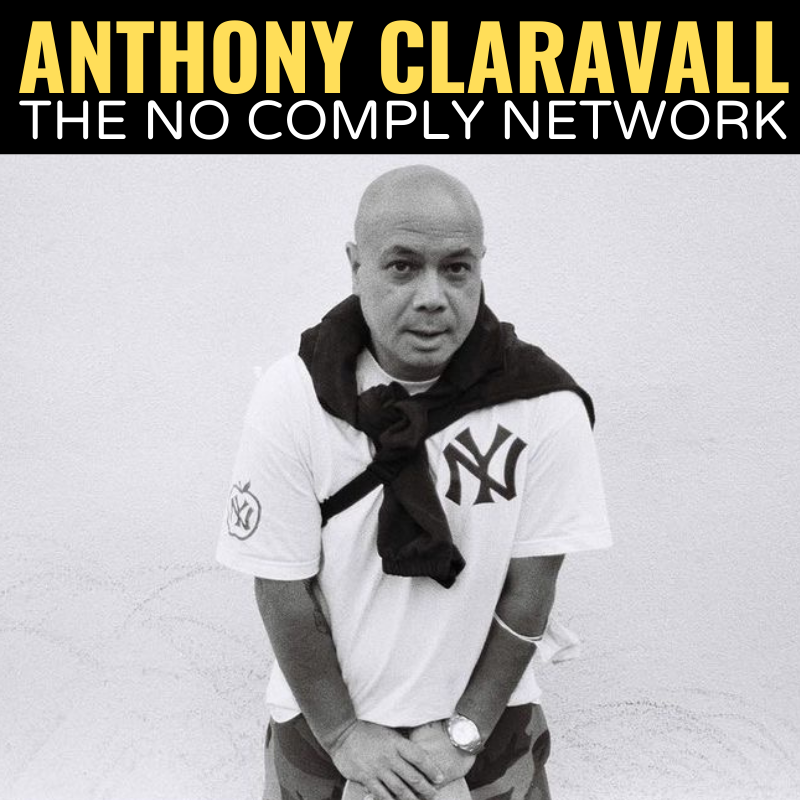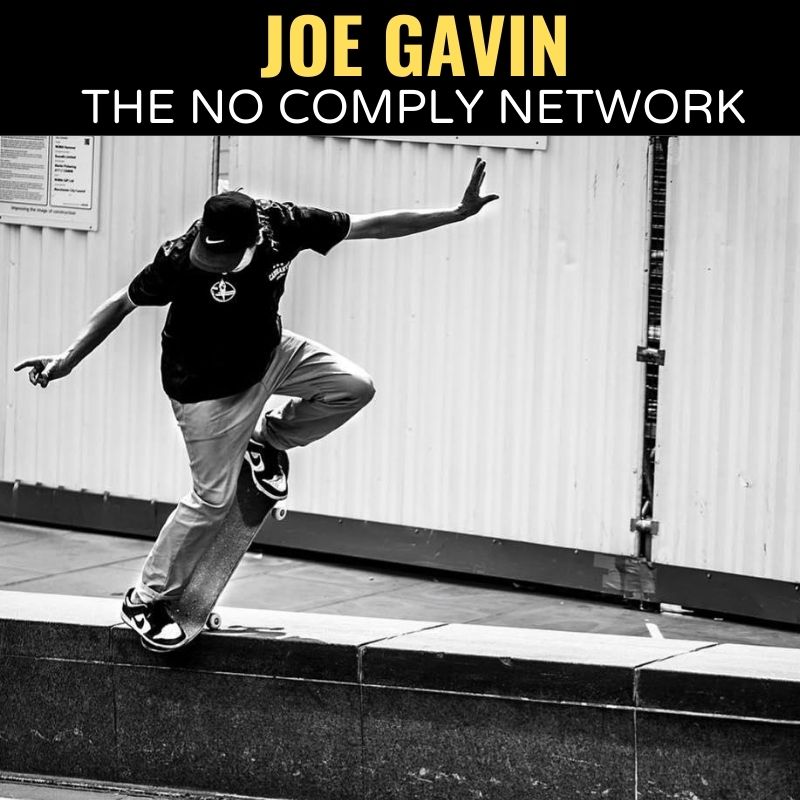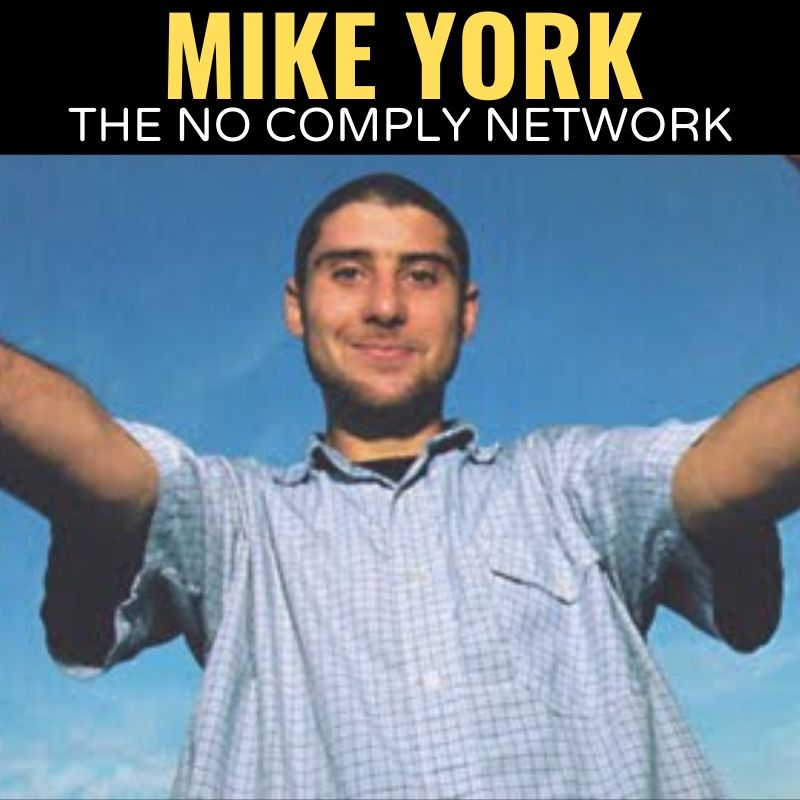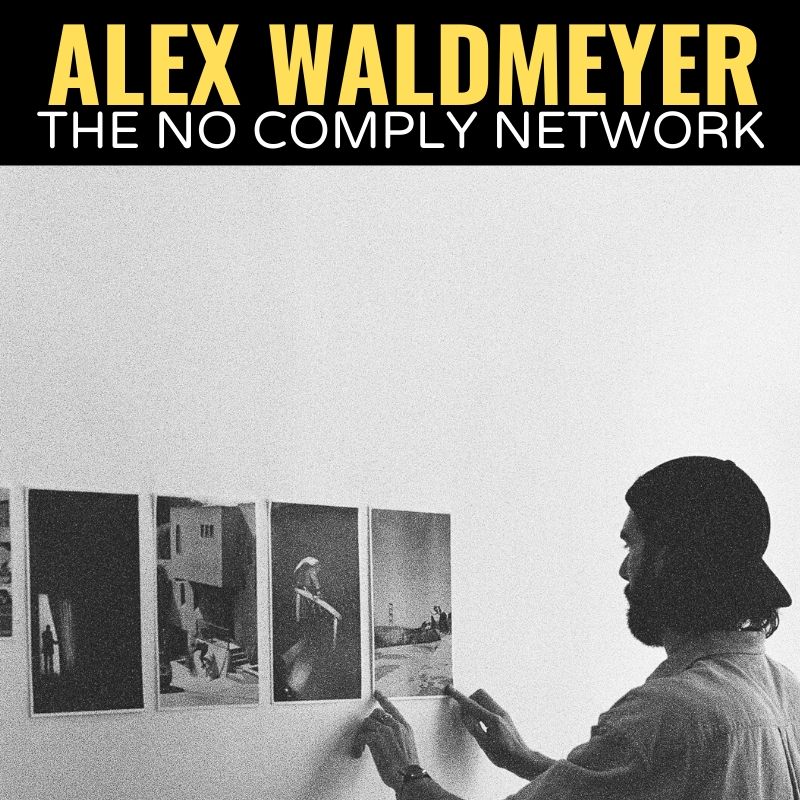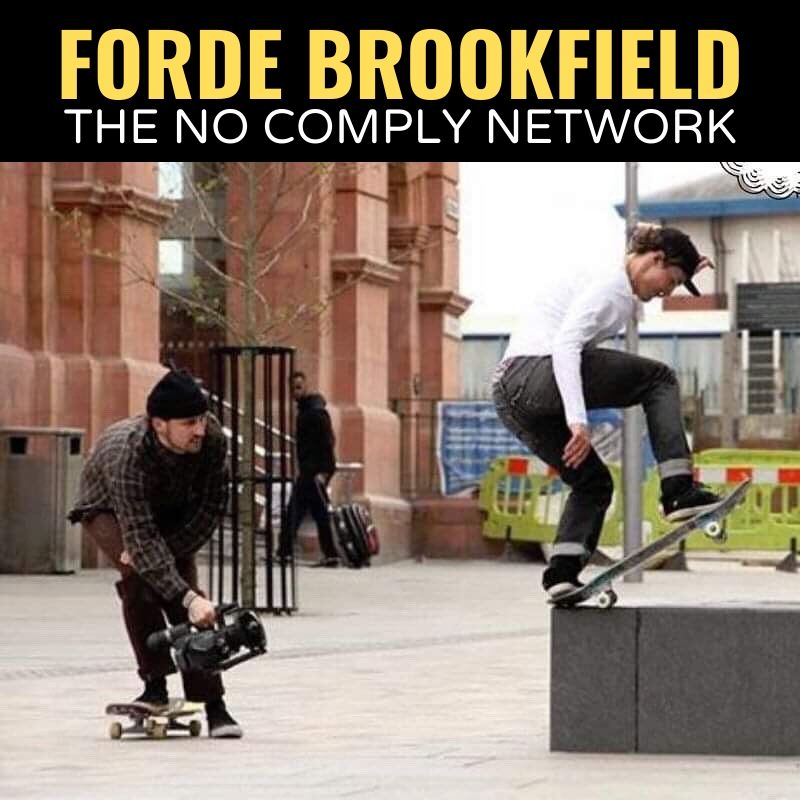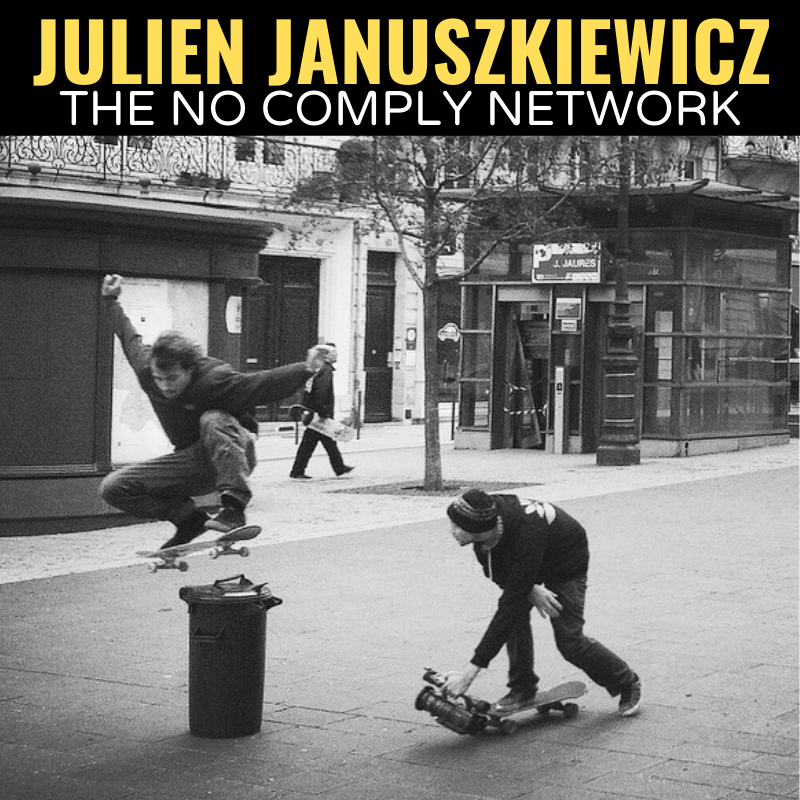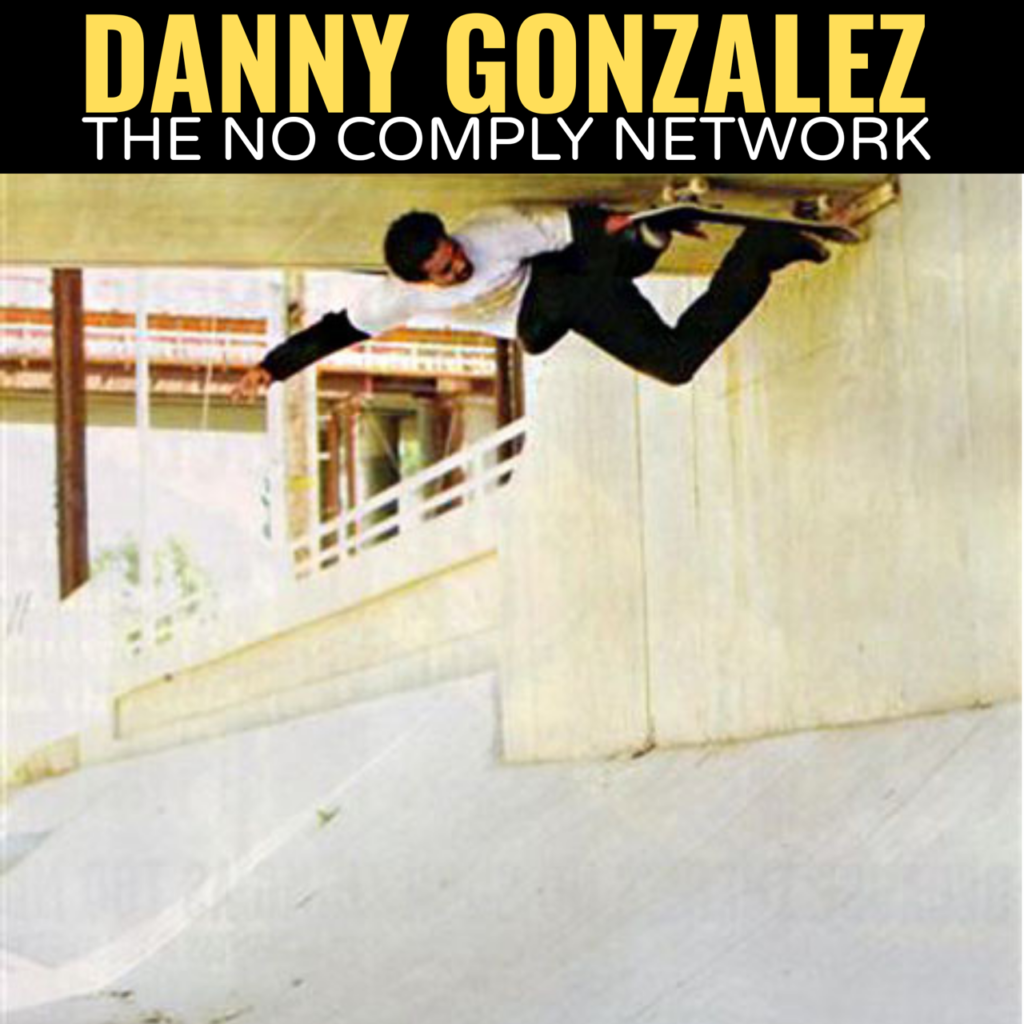Anthony: Shot by Ando
Anthony Claravall has documented some of the most iconic clips in skateboarding. As one of the main videographers for 411 in the 90s and into the 00s, he’s seen a series of epic tricks go down through his lens. But it’s not just skater’s clips that he’s captured. He’s also played a pivotal role in shaping many of their careers and showcasing their personalities to the world in new lights and to this day he’s still enthusiastic to get out and film skaters on the streets.
Read his interview to find out he started filming for 411, his stories about Harold Hunter, Huf and Danny Wainwright, capturing standout tricks for The Firm’s Can’t Stop Video, Rodrigo TX, Javier Sarmiento, Wieger Van Wageningen and Bob Burnquist, filming some of the gnarliest tricks for Flip’s Sorry video, with Arto Saari, Bastien Salabanzi and Mark Appleyard, his thoughts on being a filmer, making a video part, the evolution of skateboarding from the 90s to now and more
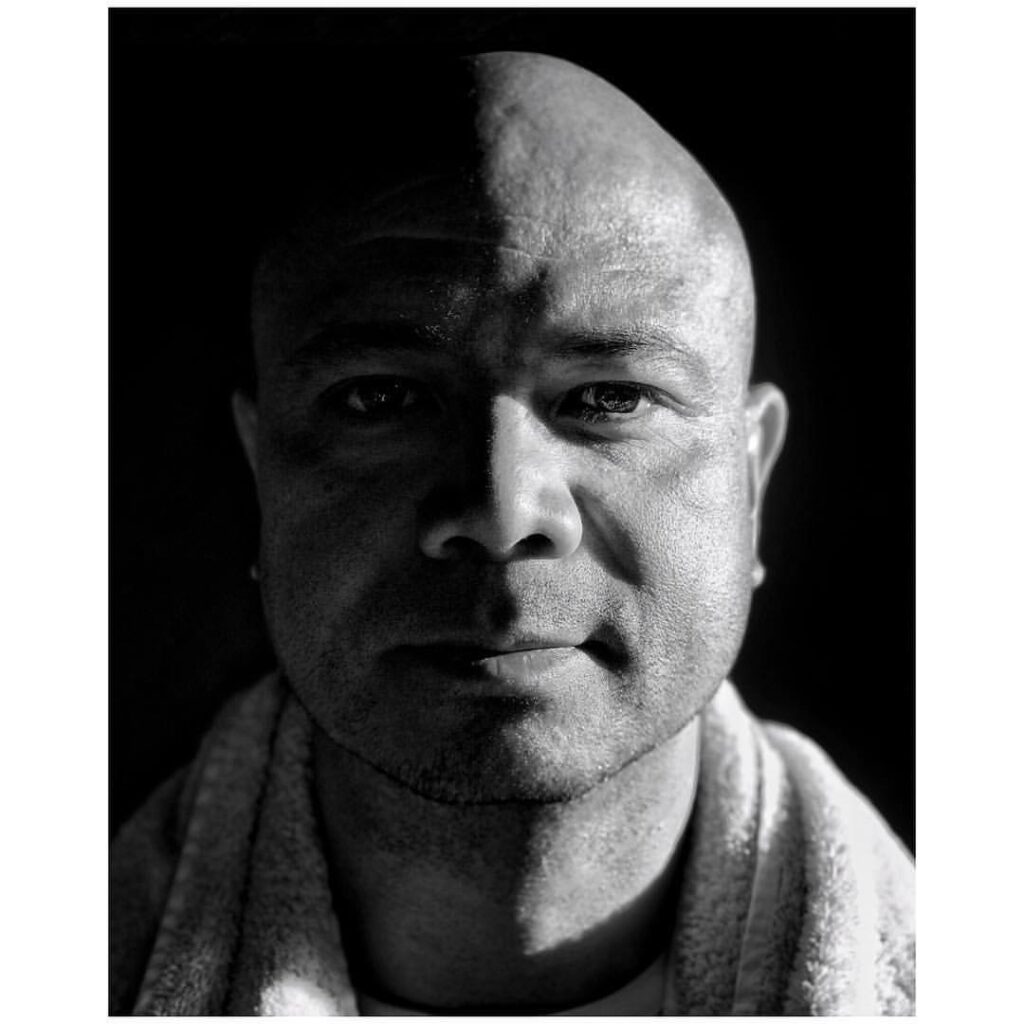
Anthony: Shot by Dani Bautista
What have you been up to recently?
I’m moving at the moment. It will be like that at the moment for a couple of months. It’s going to be the holidays so there’s no rush to get an apartment, I will get one in spring and it just happened to be like something where I’m going from trip to trip, to trip to trip, where I’m just keeping it moving. I guess the opportunities that were afforded to me in skateboarding, at the time, allowed me to travel a lot and that’s something that I wanted to do and I just took advantage of it.
How did you start working for 411 as a filmer?
The very first issue of 411 was a big thing in skateboarding. This was 1993 right. This was the first video magazine. It had esteem around the world. It had pros from every company. To be honest, Santa Cruz did a thing called Strange Notes, prior to 411, which was really the first thing of its kind but that was very much all of the NHS companies. So it was that format, with their companies and riders.
411 was the very first thing like that but it was all-encompassing. Even though Giant Distribution put it out, they tried to put everyone in there.
Right
So after the first 411 came out, at the end of it there was an address that said if you had any footage you should send it to them. I was just like fuck. I had a friend who shot photos for Transworld in Boston at the time and I asked him some questions. He gave me some pointers and I sent in some footage.
Basically, it was Josh Friedberg, who was the 411 Editor at the time, who I started corresponding with. He was hugely influential. He was the guy who kept telling me to send more stuff in, he was really positive and welcoming.
Then also, Chris Ortiz was the Managing Editor of 411 who took me under his wing and gave me lots of opportunities. Even though you could say Steve Douglas was the boss, Josh was the editor and Chris was the coordinating editor, who was figuring what should go into the magazine, and it was those two people that I owe everything to.
Those guys, maybe they saw an enthusiastic kid from New York, who wanted to film skateboarding and they gave me the opportunity to do that.
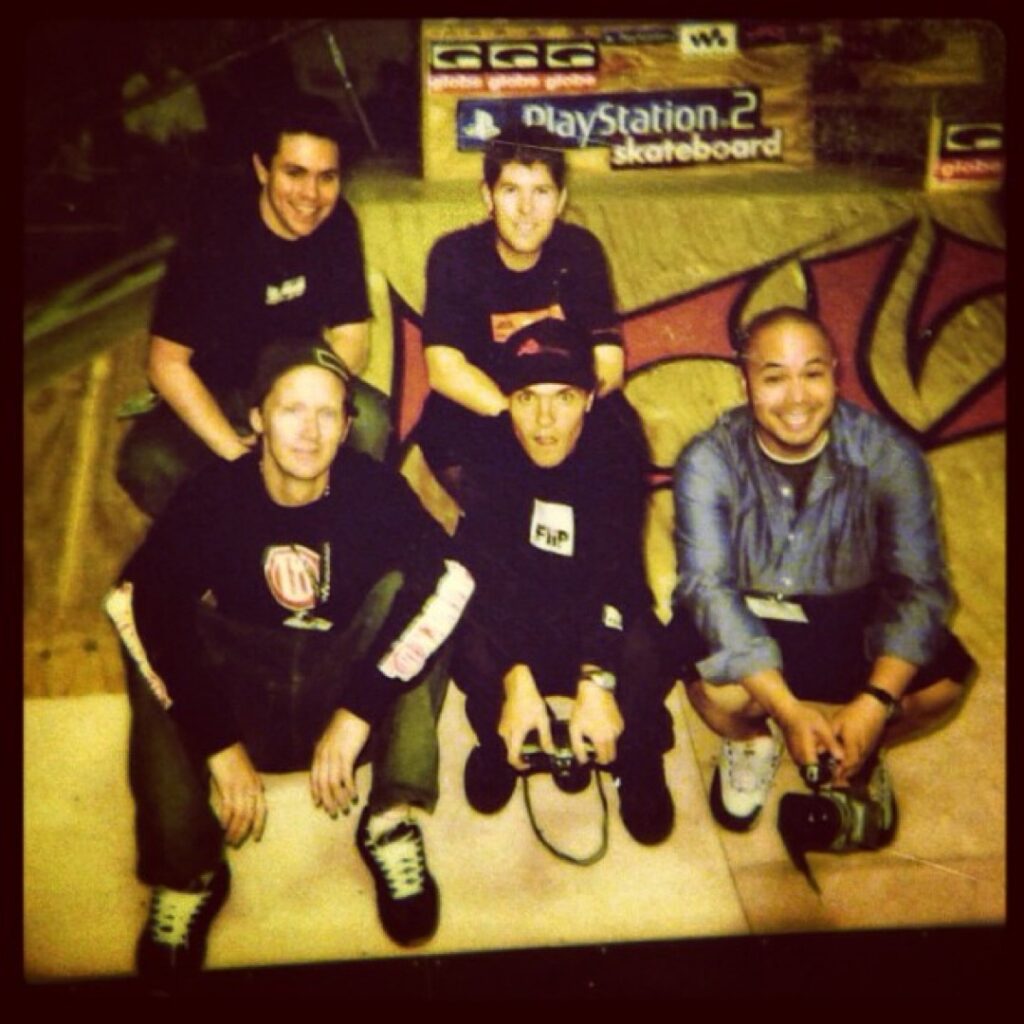
Anthony, Fred Mortagne, Colin M Kennedy, Ricki Bedenbaugh and Mike Rafael, Dortmund, 2001
That’s sick. Looking back at 411, it’s a library of the highlights of 90s skateboarding. Was there a trick you filmed for them that you thought was particularly special?
Yeah, there’s so many things. A lot of things will hit you in the face. Amazing tricks. Like oh shit this is insane. There was a race to do a Nollie Heel Noseslide on a handrail. Danny Montoya did one down a handrail at a demo in Texas at Make-a-Wish. A few weeks later Eric Koston did one on the street and it was the cover of a magazine. So I filmed Danny Montoya do that but knowing that this is a new trick that people are trying. It’s a thing. That’s just trick-wise.
I remember doing one of the first profiles I did for 411 was with Gershon Mosley. He was like yeah man I want to go to Hubba Hideout and do Switch Smith Grind before Eric Koston does it. I remember him saying it and I was like this is insane. The trick is insane but also because he wanted to do it because he knew somebody else was going to try that. So we went there and he did it. Haha, you know what I mean? I’d never seen that before. I’d never experienced that before.
Somebody with that much talent, calls out a trick not just for the fact that they have to do it or want to do it but realises that they have to do it soon because someone else is going to do it and that they had the ability and the talent to do the trick and that I was lucky enough to be able to capture it. So there’s that kind of stuff.
What other things from 411 stand out to you?
Then there’s also other kinds of stuff in retrospective, filming someone like Mark Appleyard as a kid, as an AM and Brian Wenning as an unknown kid and then later on they become superstars in skateboarding, with a pro shoe and board and everything and that’s special too. Because you get to see where someone came from. You see a little kid become a big player. Coming from obscurity but then going on to become a household name in skateboarding. Both sides are cool. On the trick side, there’s a long list of tricks I was able to document. Crazy ones, over the years.
Yeah, anyone who has done a Nollie Heelflip for the first time over the years can relate to how next level it is to do one so high that you can do it down a handrail.
It’s insane man. I started skating in 1986. At that point flip tricks were not caught, they were not popped. If the board flipped, it flipped. I remember seeing Tim Gavin in Tim and Henry’s Pack of Lies and I saw him pop and catch a Nollie Flip and catch it and it was a revelation. It was not too many years between seeing that and seeing people rolling tricks on the ground, to seeing people do them on handrails, it was insane. Then there are people that I skate with and that I work with.
Like who?
I was really lucky when I first started filming professionally to be filming with Steve Caballero. He’s one of the biggest names in skateboarding, somebody who when I first picked up a skateboard was already a huge pro. To be able to film with Cab was insane. He had seen everything.
His perspective of what professional skateboarding was is unique, he was there before street skateboarding.
If I said I started in 86’, he started skating before 1970, let’s say when he was like 12 or 13 years old. It’s interesting.
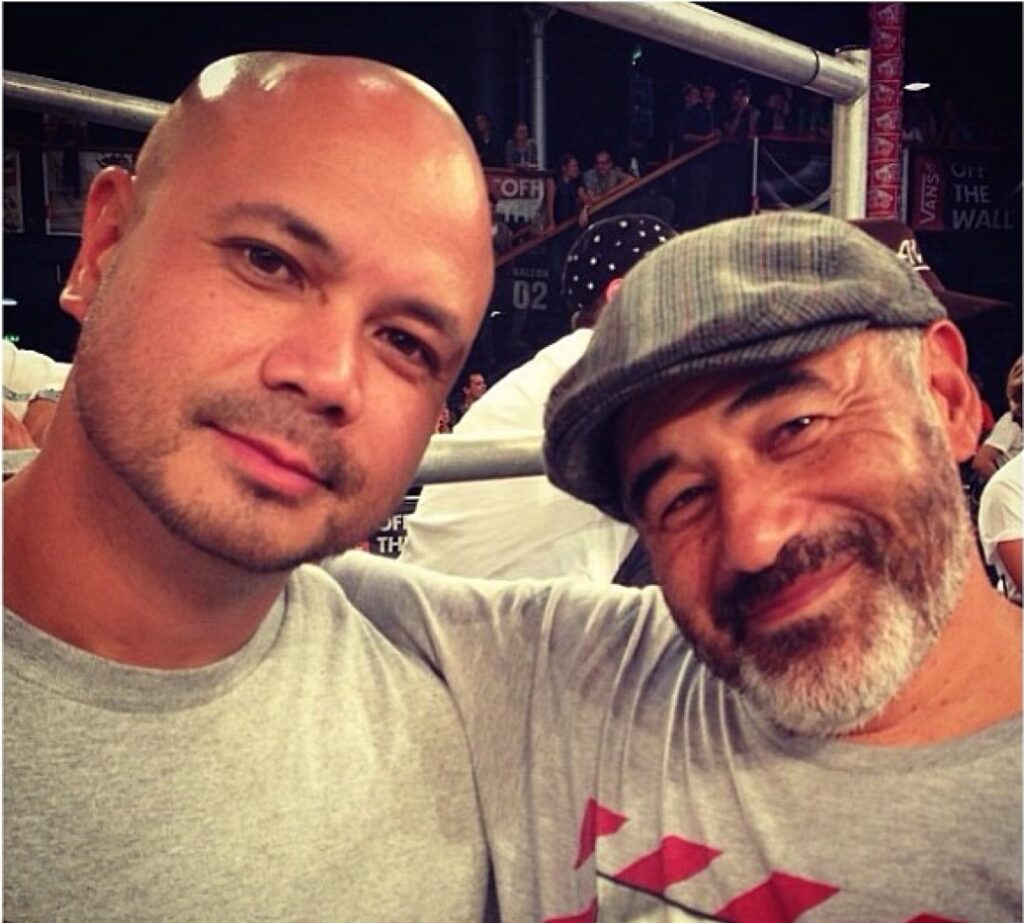
Anthony and Steve Caballero
If you talk to kids right now about 411, they don’t even know what that is, they don’t know what a VHS is or a DVD. To understand what that was you had to be there.
Skateboarding is living and breathing on their phone and if they see a kid skating in Uganda they can see it immediately and it can go viral.
It’s really crazy to understand that there was a time when there was a bottleneck in skateboarding. First, you had to see it live at a skatepark or somewhere, then a video, that would come out once a year, then a video magazine, that was a little bit more, now there is no gap in time, it’s just like instantly on your phone.
Yeah, for sure, I used to watch James Woodley shred back in the day in Birmingham and always thought he was next level, loads of the tricks he did were just on the spot and never were documented.
You’re talking about James Woodley from Birmingham? Yeah he was someone who I skated with when he was like 14/15, it’s insane to think about that he was the little kid who had to go to the United States to make it.
But now there are kids where the opportunity is where you can just be in your local scene and be at home and create skateboarding. It’s interesting to think about with a perspective.
Yeah for sure
The great thing about skateboarding is that you don’t need to think about it. You don’t need to think about anything you can just take it in, nobody has to explain to you that this trick is hard or insane or unbelievable 10 years ago because now it’s like something that people can do every time.
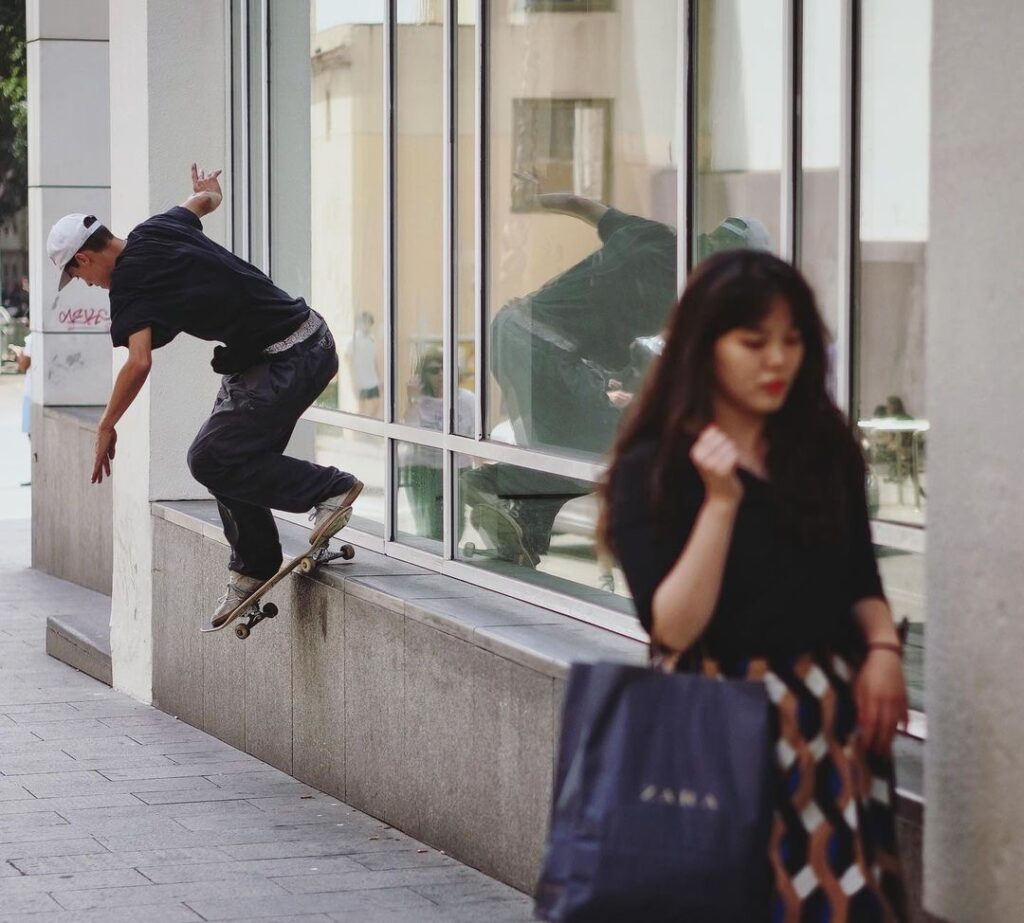
Pedro Biagio, Backside Smith Grind, Barcelonaa: Shot by Anthony
At the same time, there’s still magic to it. There’s something cool about seeing a trick and being blown away but also the feeling of going to a spot with your friends and seeing them do something that you’ve never seen them do before.
You are absolutely correct. I guess I’m just trying to speak from the experience of seeing skateboarding and the experience of doing it. Skateboarding is so fucking hard. For me to do a trick up a curb and then do a trick off of a curb, to do two tricks, one up, one down, that might be more effort than for another person to do the gnarliest trick on a handrail or something. Everything is so different for everybody else. It’s one of those things, you can’t pick up a skateboard and be good at it immediately. You have to put in hours. It’s one of those things, you can’t be good at fast. It just doesn’t work, it’s amazing. Skateboarding is fucked.
So when you saw where skating was going to be, what hyped you up to stick with it?
I’m a skate rat. I remember walking down the street 30 years ago and looking at a spot wondering “I wonder if somebody could Kickflip that?’ or like it would be so sick to Nosegrind that and then really quickly hit that, right after or whatever and now almost everything that you can think of is reality.
For sure
There’s no ‘thing’ .Like, “nobody’s ever skated a rail bigger than an 18-stair before, it’s insane!”. Now it’s like, no you see people skate triple kink rails and each section is 20 stairs. It’s really like that.
Oh the Full Pipe, you’ve never seen anyone do that. I went with Bob Burnquist when he went to loop Baldy. It was a 5 am mission. It’s never been done before. It was this thing. It’s secret, it’s illegal to skate there. You had to park really far away. We had to hike in. He ended up breaking his ankle. You know what I mean? Now it’s this crazy thing where the people have done the loop switch. He’s done the loop switch. Evan Mock has done it. People skate Full Pipes now, they just do it.
Yeah now you can watch Bob do it with the hole in it. So in your journey as a filmer, you filmed for 411 and documented those skaters who became legends along the way, but I never really associated you with a particular brand. Were you ever working for a board brand at that time?
No, not really. So, I started filming for 411 and as I said earlier I was taken under Cab’s wing and I filmed a lot of stuff with him. He opened up a lot of doors for me. He got me a job at Powell. I was there for about 3-4 months filming a project for him and he introduced me to Lance Mountain.
Filming Lance and for The Firm was a huge thing for me, and doing that, that’s how my friendship with Lance and a lot of the guys who skated for The Firm started. But a lot of that had to do with Frank Gerwer also.
How did Frank come into the picture in your filming career?
Frank is from Long Island, New York and I’m from New York City. We kinda came up together. He was one of the first guys I was filming in New York. We were always together, we were always filming.
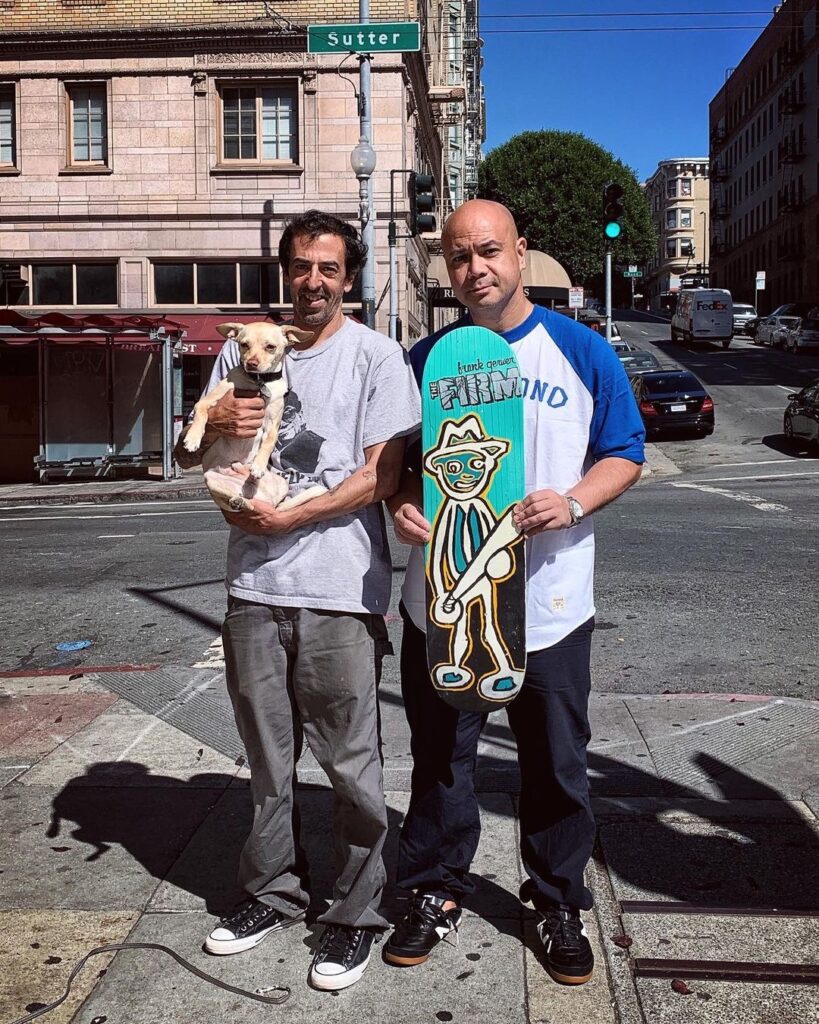
Frank Gerwer and Anthony: Shot by Sanggoe Darma Tanjung
Right
He ended up getting flow for The Firm and he ended up getting on and I kinda tagged along. I was his filmer, his buddy. So that’s how it started at The Firm.
Long story short, Frank started skating for Antihero but I stayed at The Firm. So I ended up being at The Firm, and then there was a new generation of kids – Rodrigo, Wieger, Javier and to this day I’m still really close with all of them and that’s why it was special to me. But that’s the reason why I was at The Firm.
But to be honest it was all about 411 and The Firm was a bit of an outlier. I did not work for any companies, because at the time you had to work for a brand or work for 411. Or you would contribute to 411 but just the footage from the guys at that brand that you were at. I was very much like, I want to film with as many people as I could.
It was a strange kind of currency. Like I would talk to somebody and they would be like I want to work on a part for 411 and they would be like yeah that’s great but there was an unspoken rule, knowing that if they got something really, really good, that they would save it for their board brand or shoe brand’s video.
Filming someone say like, Rick McCrank for example for 411, if he got something, he would know if I’m going to try this trick and this is going to be for the éS video. I’d be like that’s cool.
OK
411 would know that at that level, that if there were 10 good tricks, but had that one amazing trick in there that would have to go to their video part, that’s more important.
So I would film with Rick McCrank and a bunch of other people and there would be footage that would go into their board brand video or shoe sponsor video like the éS video,
I filmed a lot of the guy’s last tricks in Flip’s Sorry video but it was very much that we were filming for 411, so when they did it, they would say I’m going to keep this. I would be like that’s cool, it’s a no-brainer, know what I mean?
Yeah
I ended up filming Mark Appleyard and Bastien Salabanzi’s last tricks in Sorry but I did not work for Flip.
That’s sick how you played such a big part in all of these epic videos like that.
I filmed Arto’s Fakie Flip at MACBA but he Switch Flipped it first for 411. Even at that point, Arto Switch Flipped it, he did that for 411 and the Fakie Flip that was for Sorry.
But then later on in the same day at Plaza De Catalunya, there’s a big street gap, he Backside Flipped it and Switch Backside Flipped it.
So I was like ok, Backside Flip for 411 and Switch Backside Flip for Sorry but then they ended up wanting to use both, understandably in Sorry because there was a little bit of a thing.
But even then it was like Arto knew this is something I want to keep for my video part and this is something you can have for 411.But that’s kind of special too, because in retrospect, Sorry, was such a huge video.
For sure
Appleyard, Arto, Rowley, all Skater’s of the Year. It’s insane. So I’ve been lucky enough to film with all of those dudes. So it made me feel like wow, this is crazy, when you’d film a trick. Now you’d film a trick and the world knows about it immediately. Back then you could film a trick and you could sit on it for a year.
Now it’s all about posting it as soon as you can basically
I will never forget this. I knew Arto before he was on Flip. I met him in Europe at the contests. You could tell he was just this amazing kid and he became ‘that guy’. I’ve known him forever. I heard he did a trick down the triple set in Santa Monica for the éS Video and somebody said that to me.
So I saw Arto at the Sole Tech offices one day. And I was like damn dude I heard you got a trick down the triple set and he was like “No, No I didn’t, who told you that!? I haven’t done anything down it!?”. Blatantly lying to me but that was the level of things at the time. He had done it and he did not want to get out. Even blatantly lying to your friends that was how it was. Now it’s the complete opposite. You do a trick your homie filmed and you post it and now it’s the best thing ever.
Tricks today don’t have the same impact as those kinds of tricks he did.
What struck me recently, I’ve been in a van recently with a skater who has had 10 video parts, 5 covers, and 3 pro shoes across 3 brands, and sat next to a kid who’s like 15, who’s never had a video part. The kid has never bought a magazine or read one because there aren’t any and he does not know any of the 3 shoe brands that the guy next to him had a pro shoe for. He only knows Adidas, Nike and Vans. You know what I mean?
It’s that. It’s not because they are not having the times of their lives and haven’t accomplished it, it’s actually because those milestones are not even there any more. There is no magazine. So you have to explain to somebody Thrasher, it’s not a t-shirt company, it’s an actual skateboard magazine and if you had a cover it was a big deal. You could explain it, but kids now would not know that the actual reality of having a cover was huge.
Talking to the same kids from this era, like have you had a video part?
“Video part?”
“Yeah, a full video part?”
“Like the full three minutes of an Instagram reel? You mean the full 60 seconds for a hard post? Yeah, I’ve had a video part!”
“No, no I mean a video part where you travel for three years and you film the best tricks and a guy gets the first part and a guy gets the last part and the kid’s like“I’ve only been skating for a year and a half, I’ve never filmed for anything for three years!”
So even the idea of a video part, doesn’t mean anything to him in the same way that the older dude does.
Yeah, how we value footage is so different now, especially across the generations. How have you found that change?
You’ve got to lose the ego. To be a good filmer, I believe it’s really about the skating that you’re filming, it’s not really about you. You are a vessel to capture or portray skateboarding that other people are doing.
That’s the first thing, it’s not about how long it takes, it’s about it happening and the skater and the trick. I remember I had stopped working for 411, 411 as the business model was fading out, this was in like 2008. I had an opportunity to work for LRG to do a video which was ‘Give Me My Money Chico’.
So I was working for LRG and we ended up at the annual Make a Wish jam in Texas and I was already out of 411, filming for LRG. So I was with the LRG team filming and Chris Ortiz was with another team.
Brian Schaefer, was on the mic as Dennis Busenitz was skating, somebody else was skating and he was like “Chris Ortiz, 411, Anthony Claravall, hey put your hands together kids, do you guys remember 411! ”and it was fucking crickets in there. This was 2008 and it was fucking crickets in there. None of the kids said a word.
I looked over at Chris, Chris looked over at me and in that moment, we realised it was done. 411 was not relevant. Websites were the new shit. Magazines were still around, so the photographer was still king but the videographer was like nothing.
How did you react to that at the time?
You’ve got to keep your ego in check obviously and if that’s the case, you can’t get a big head if you get a wake-up call like that right?
I think it’s all about understanding what’s important. For me, I love skateboarding. I really enjoy capturing it. I love filming. I love putting together a video part and I love helping a skateboarder show how good they are, or what they have to offer and I love travelling and all that entails and everything.
So that’s the focus. It’s not for everybody. Some people want to have their name on a project, they want to be things. It’s definitely laudable.
But for me, the way I have been navigating things, I try to do what’s important and hold on to things that need to be held on to and try to understand that skateboarding is seen and consumed and delivered in a different way and kinda be able to roll with that and take advantage of things.
Even when the full-length video was kind of dying. Tyrone Romero, at LRG, offered me the chance to make a full-length video.
I had never made a video by myself so I grabbed that opportunity and I made that video for me, so there was that.
There’s been other things at other times in my life where there’s been opportunities, where it’s not exactly what I was thinking but then thinking fuck, if they can coincide with things that I want to do, then it’s cool. Something I can put my energy into and I think that’s really it.
Definitely
We’ll have a conversation in 10 years and be like remember Instagram Stories? That was a hot thing for a second. So there will be a generation of 14-15 year old kids now, they will be 30 one day and they will be reminiscing about the early days of TikTok and YouTube.
Kids will be like “Damn dude YouTube used to be so dope! Remember the first year before the government shut down TikTok, you remember how rad that was!?”. It’s the same kids who are fetishising Baker 2G now or whatever. I’m guilty of it too.
Greg Hunt had a Top 5 video parts thing on Quartersnacks, he referenced and was talking about Sick Boys and all of these videos with Julian Stranger, Mickey Reyes and Natas Kaupas and all of these things that have really stuck with him and he’s been trying to make that video part again all these years later.
I’m from the same generation and I totally feel like that. But it’s also a little bit funny to think about that because it’s like who’s to say if somebody from 20 years is like, I want to capture that feeling of when you wake up and go through your phone and go through your favourite skater’s stories and one dude is doing a crazy trick and the other dude is making food . I would be like, you’re insane, that’s really strange but it’s natural for them, it’s what they want to see because it’s what they grew up with.
How did you get into skateboarding?
My first experience of skateboarding was when I was a little kid. I rode a BMX bike. I didn’t even BMX, I just had a BMX Bike. I would ride it around. Older kids would have BMX magazines and in those BMX magazines, there would be some skateboard ads. There would be a mail-order place that would have skateboards and there would be a page of skateboards.
So I would see the boards and be like ah that’s cool a skateboard. Not even knowing what it was. I vividly remember seeing kids skateboarding. I remember being in a car and seeing these kids skateboarding and Ollieing down these stairs thinking fuck, that’s the coolest thing that I’ve ever seen, thinking that I wanted to do. But that was just like for 5 seconds. This was the mid-80s.
And then I moved to a new school. I was kind of a punk rock kid. I was into Hardcore. In New York there was a huge Hardcore scene. Hardcore and skateboarding were really hand in hand at that point. I remember being a little kid and buying Thrasher and looking at Thrasher in the newsstand because there would be an interview with a band but then there would be skateboarding and some of it I could not really understand. :ike there would be a guy in the air on a vert ramp and I didn’t understand how did he get into the air, just like gravity takes you out of the half pipe?
But then street skating was something that I could see and I could identify with.
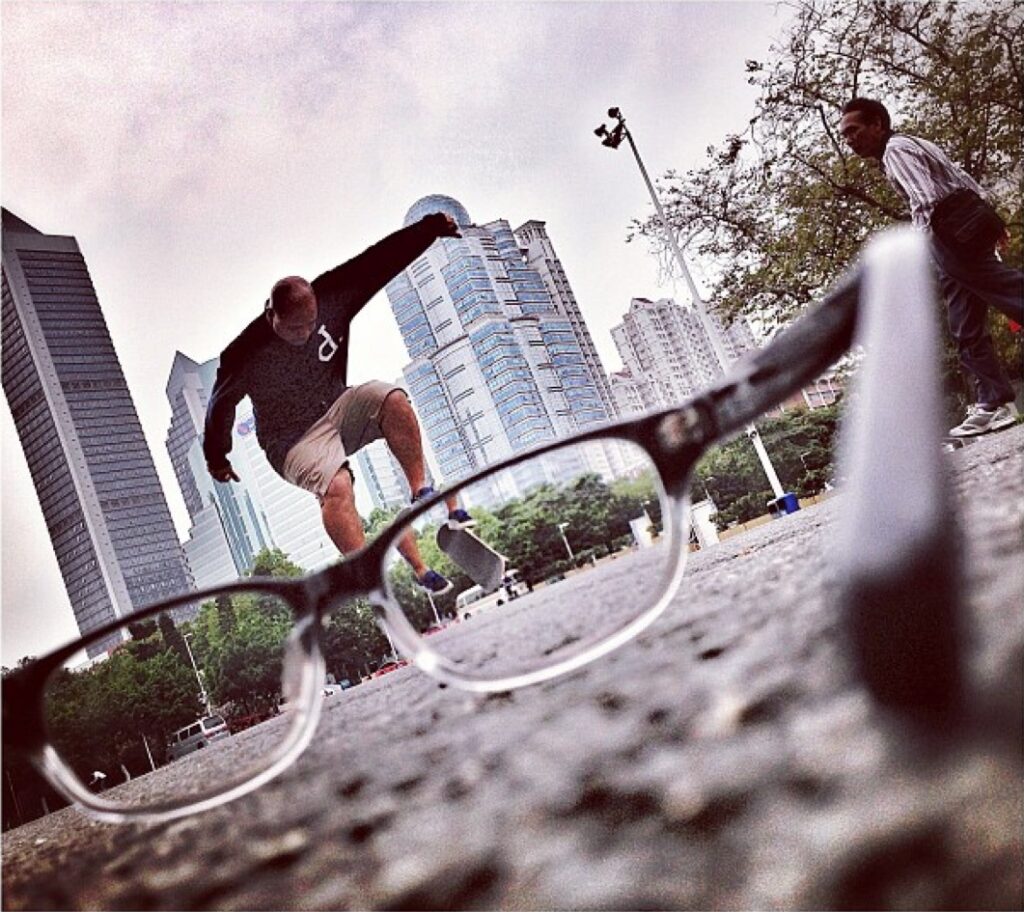
Anthony, Frontside Shuvit: Shot by Jamie Thomas
I moved to a new school and one of the kids that I met there was skating and so then I started skating.
I had some friends who I would ride my bike with or whatever. One of their older sisters was dating a skater, he had a board but we would never really see him skate and he left it at her house so we would skate that board around.
We wondered if he would ever want it back one day but he never did. Things like that. You find your crew and you started skating, and it became a thing, this was around 1986-1987.
Rad
Skateboarding was a really different thing. You couldn’t just buy a deck. There wasn’t even a skate shop. You could buy a complete but you had to go to a BMX shop or a sporting goods store.
If you wanted a Santa Cruz board with Trackers and G-Bones you couldn’t do it. You could get a Santa Cruz board with Indys and Slimeballs. Or you could get a Tommy Guerrero Powell board with Trackers and G-Bones but you could not set up your own board. You just got whatever complete they had.
I started skating and I was into a lot of things, riding my bike, punk rock, and comic books but when you start skating everything goes out of the window. I still like going to shows but skateboarding quickly became the only thing that mattered to me.
Long, long story short it’s just like how do you stay in that, how do you become a part of that world? I wasn’t a good enough skater to be sponsored.
The only other option at the time was to keep skating, turn pro and be that dude and I already knew pretty early on that wasn’t going to happen.
Who were the guys in NY smashing it at the time?
The epitome of skateboarding locally was that guy who got a free board from the shop or that guy who got a free hat. I didn’t know anybody sponsored, you would not see anybody sponsored. Then towards the end of the 80s- early 90s, some guys would be like this guy skates for a small East Coast company that you locally would not have even heard of.
Now there’s so much progression. Now there’s three pro skaters for Girl Skateboards from a suburb of Seattle. That was unheard of before 2023. There are three kids turning pro for Girl Skateboards, one of the biggest companies, from there but that was not the story 30 years ago, there was nothing like that, you would think you had to be in California.
There were people like Peter Huynh in New York who ended up riding for Underworld Element.Harold Hunter. Harold Hunter was the best skateboarder in New York at a certain point.
What was it like skating with Harold at the time?
Kinda crazy, Harold was a bit of a loose cannon. He was living in the moment. He was this kid from these projects. I knew Harold really well. We’d all skate Astor, everyone would skate the banks. But it wasn’t like “Hey, let’s meet at this ledge tomorrow at 3 pm or whatever, it was just like you’d go to the banks and start skating and you’d see everyone skating or you would see them at Astor.
I remember when I started filming for 411 and I did a Rookies with Harold, this was a year later, he was already sponsored, he was already pro.
We would have to film something and I would be like shit I had to go to the projects where he lived and I’d page him. Maybe he’d call you back or maybe he wouldn’t. I’d just have to go to the projects and kinda be around and then I’d be like oh shit is that his sister and I’d be like is Harold around? Then she would go in and check and maybe he would come out or maybe he wouldn’t.
Now you just email the dude and you meet a guy at the spot, they’ve already got a cup of coffee and they know the tricks they want to do, it’s so crazy.
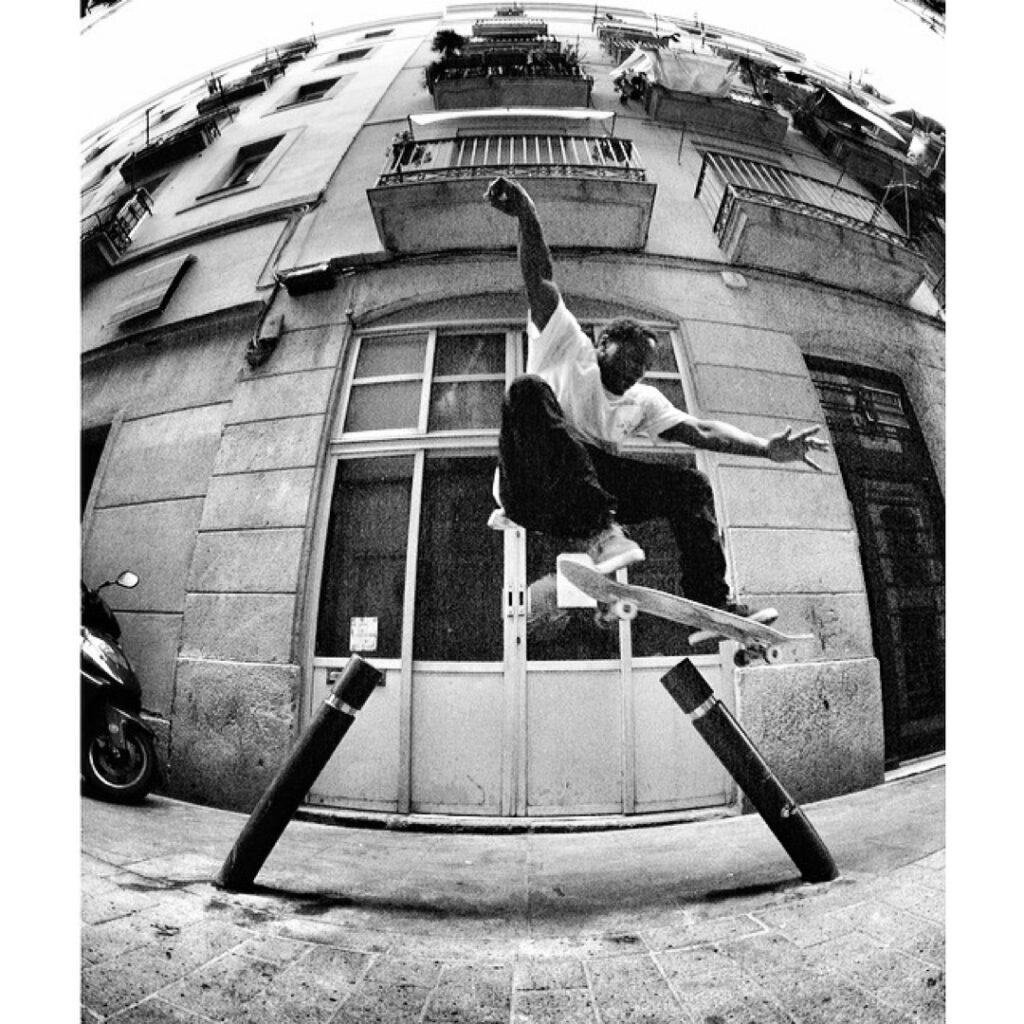
Jabari Pendleton, Pole Jam to Pole Jam, Barcelona: Shot by Anthony
Who else was killing it on their board in New York?
There were a lot of good skaters that I would see as a kid. Keith Hufnagel was the king of New York but he left pretty early when he was 18. He went to San Francisco. Keenan too. Gino. These were the best skaters. But a lot of them at that point had to leave New York. Even though California wasn’t that far at the time it was like Mars. It’s like where’s Huf? He’s in California, oh he made it!

Keith Hufnagel, San Francisco: Shot by Anthony
Why’s that?
It was unknown. It was California. Huf went to SF to go to school, to go to college, but that quickly went out of the window because he went pro. He rode for H-Street and then he rode for Fun and that became Real.
We talk about things and you hear stories. I was just like a kid, I wasn’t in the inner circle. I wasn’t privy to things really. You’d hear stuff and be like “How is SF?” or “Did you skate Embarcadero?” and they would be like yeah it was cool. Now the flipside is that people will fly to the other side of the world to skate a handrail and then fly all the way back straight after.
How did you get your first camera?
One of my older sister’s boyfriends had a video camera and they never used it and it was just there. I remember borrowing it and filming my friends. That was kind of it. One of the first crews I had, the filmer by default was because his dad had a camera. So it was his camera. He was able to borrow that VHS camera, so he was the lynchpin.
The next one I bought was the next cheapest one I could l buy. I had a friend who worked for Transworld, he shot photos. He was like you should buy this kind of camera, it has optical stabilisation, you want optical, you don’t want digital. Whatever advice you could get, you followed.
There was no Google. I was very lucky. That being said, I could go to B&H in New York and I could see the most amazing cameras there and see them and touch them and feel them. I was really lucky. I could see that and understand that this camera is $4000 but this one it’s $800 and I could get that by working in the summer and the better one that was $1200, I can’t really do that.
The guy who was working there or at Adorama would tell you, this camera has this and that. So if you’re from a suburb in Cleveland, you can’t use that resource, it must have been even crazier.
What was the first camera you were really stoked on?
I had a TRV-900 which is a really good Prosumer camera. It wasn’t really pro but it was a bit more than an entry-level camera. I remember I filmed with that level of camera for a long while but then I wanted to go to Europe. Then they did a video called Europe 1996. They went to the UK and Germany and I was like I want to do that. I wanted to go the next year.
So right before that I bought that digital camera and sent a letter to 411, and I was like, hey I want to go to these contests, I want you guys to send me, this is my plan. I said I would film a Profile video segment with Danny Wainwright and then I’m going to go to Holland and do this and this. I just bought this camera, I want to go!
They hit me up and they said, ok cool, you’re going. They got me a flight, and a Euro Rail pass so I can go to all of the contests and all of this stuff.
The VX1000 had just come out also but it was a bit of a higher level. 411 had a few VX1000s. And kind of after that, I would have one of those 411 VX1000s or my own as became the benchmark for videos. But prior to that, it was the TRV900 that I was super hyped on. It came out after the VX1000, so it had better low light, and a crazy zoom but it didn’t have the MK1 lens but yeah that was one of the cameras.
What was it like filming Danny Wainwright’s 411 Profile in Bristol at the time?
I filmed Danny Wainwright‘s Kickflip Melon down Lloyds. I filmed that whole part. The crazy thing is, it’s the same as Javier, Rodrigo or Wieger, I’m still really good friends with Danny to this day, that’s my fucking homie. He lives in Barcelona, we spend a lot of time together, we try to spend a lot of time together.
It’s a little bit of a testament to how a lot of these guys and these video parts. Yes, there are some dudes I just met and filmed a trick or whatever.
But there are a lot of people I filmed with, I wanted to film a part with them because I thought they are an amazing skateboarder and that’s what I did. Not just because necessarily, oh there’s this person, film him
Right now, I’m filming a part with Griffin Gass. I do not know Griffin Gass. It turned out, he’s best friends with a kid I film with a lot. I’m good friends with a lot of people at Girl but I don’t really know Griffin. I love how he skates, I wanted to film with him and now we have a project together. It’s a big thing. You want to work with talent. I wanted to make it happen.
Danny Wainwright at one point was that dude. He was one of the most talented skaters. Dare I say, Geoff Rowley, Tom Penny and Danny, are the best skateboarders to ever come out of England. Subjectively obviously but with their talent and what they did out of the UK as a whole, those are my top three.
I don’t think anybody would argue with that. One of the things about Danny was his sick pop. Was 97’ the year he Ollied over that full-size bin?
No, the next year, I went out there and I filmed a little thing with him and it ended up being like a world report thing in 411. He Ollied a full-size bin at College Green in Bristol. I filmed that one.
That was next level, those bins are massive. He made it look like he was popping over a curb!
Joe Brook actually shot a photo of that from the front and I filmed the trick from the back because I felt like you can really see the bin as he’s approaching, you see him snap, you see him get over it, that was really important and Joe obviously shot the photo from the front, because you want to shoot the photo from the front and see it from the front and it was in Slap and it ran as a full page photo.
I remember somebody at Slap saying, oh but there’s like a curb behind that right, there’s something behind it? And we were like no dude, that’s on flat and they couldn’t even understand that. There is something otherworldly about it. If somebody did that today, Ollied a bin like that, you would still be like that’s insane.
What were your experiences of going to Europe the year before?
I met a lot of skaters that I still am friends with today. I saw a lot of scenes that I’m still lucky to be a part of today.
I flew into Holland and I had been to Holland before and I’d filmed. I was the 411 filmer and if you said that at the time doors would open for you, the best skaters would want to film with you, people at the skate shop would drive you around. You had some cred. Believe it or not.
So I went to Holland at this thing at this skatepark in Utrecht, that they did every year, in the summer and the guy who puts it together said to me, he was busy, he was working or whatever, but he was like this kid is going to pick you up and actually you can stay at his house. So this kid picks me up at the train station. He’s 16 years old and he’s got a bicycle.
He’s like yeah man, you can stay at my house and you can drop your stuff off. I’m kinda like, how does this work and he’s like get on the back of my bike. I’m like OK. I’m like, super fucking American. I haven’t ridden a bike in years and never on the back of a bike and we’re going through the city
This kid is 16 years old. In high school, good skater. This kid ends up being Kaspar Van Lierop who was at Nike for 10 years, who’s done a lot in skateboarding and I’m still friends with Kaspar.
I talked to him the other day. He lives in Portland. He’s running Asics Skateboarding. He was at Nike forever. He’s just one example of people who I met in skateboarding and did a lot in skateboarding and is still here.
Whether it’s Joe Brook from that summer, he shot a lot of photos the next summer, he’s still a good friend of mine, Danny, people who have shops, distribution, all from that summer.
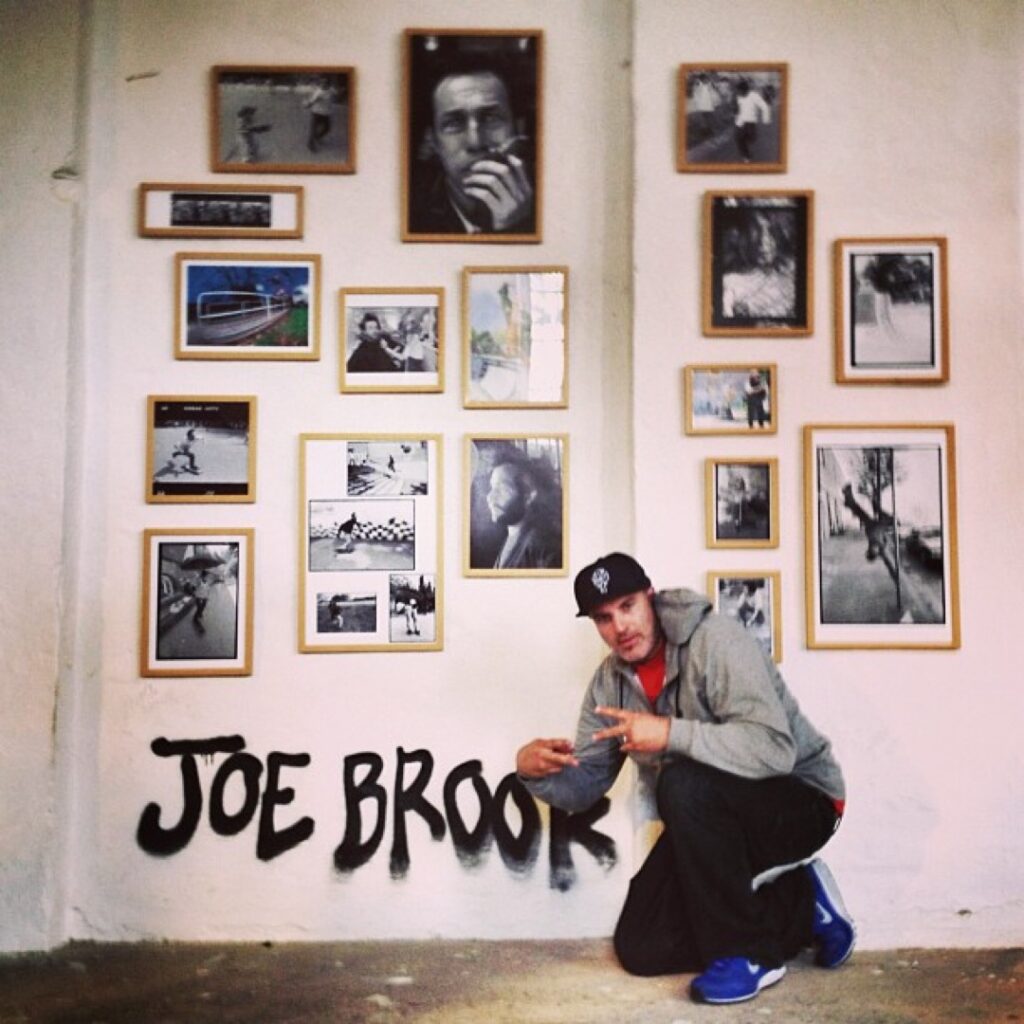
Joe Brook: Shot by Anthony
That summer I met Peter Hellicar, Seth Curtis at Slam. People I still know today. Jagger from Wolverhampton who skated in Birmingham had moved to San Francisco, I knew Jagger from San Francisco. There’s a litany. I skated with Mark Channer. Even somebody like Churchill. Met Churchill, skated with him. Years later he does commentary for the Olympics.
I’m a coach for The Olympics so I ran into Churchill. It’s a small world. There’s a lot of people from there that I still see. I feel like it’s super important that people from then are still in it today and helping steer it.
I feel lucky because I never was like I want to be an Olympic coach but the opportunity was there and I could help skateboarding so that’s what I do. That’s part of where my role as a videographer can blend into different things.
You want to film a part or film a thing or go somewhere. So you talk to the companies to send the skater. You talk to the companies and you assure them you can take care of it, assure the sponsors that something will happen, you figure out where the hotel is, so it’s cheap enough that they will pay for it. You help the skater get the flight, you pick them up at the airport. You do all these things so you can get the fucking dude to a ledge to film a trick.
All of those skills allow you to. I’ve never skated professionally but I’ve been to more pro contests than anyone that I’ve known. So in the end I do understand how to skate in a contest and what you need to do and how I’ve been able to coach a skater to a finals at the Olympics. That is 99.99 percent the skater and their talent but hopefully, I was able to provide that .1 percent of helping them to get there.
It must have been cool for them to have your experience on their side. After speaking to Humphries, I heard you filmed a lot of The Firm Can’t Stop Video.
I started off filming Frank and at that point, The Firm did not have a filmer. The Firm was Lance just pulling out a camera and filming. What was great about that was I had something that I could immediately jump into.
I started filming Salman, who just got on The Firm, I started filming Ray Barbee who was on The Firm, and I started filming Lance. There was Weston Correa and James Qua who was still on The Firm. James ended up quitting skating. Weston blew out his knee. They started putting on some new ams. Frank ended up quitting.
Right, so who did you really connect with at The Firm?
My crew really became Rodrigo TX. I clicked with him. He didn’t really speak English and I couldn’t speak Portuguese but for some reason, we could communicate with each other. We were always really close. He was always an amazing skater. He was a next level talent for The Firm. It was exciting for me to film with him. I was like dude this kid is fucking amazing.
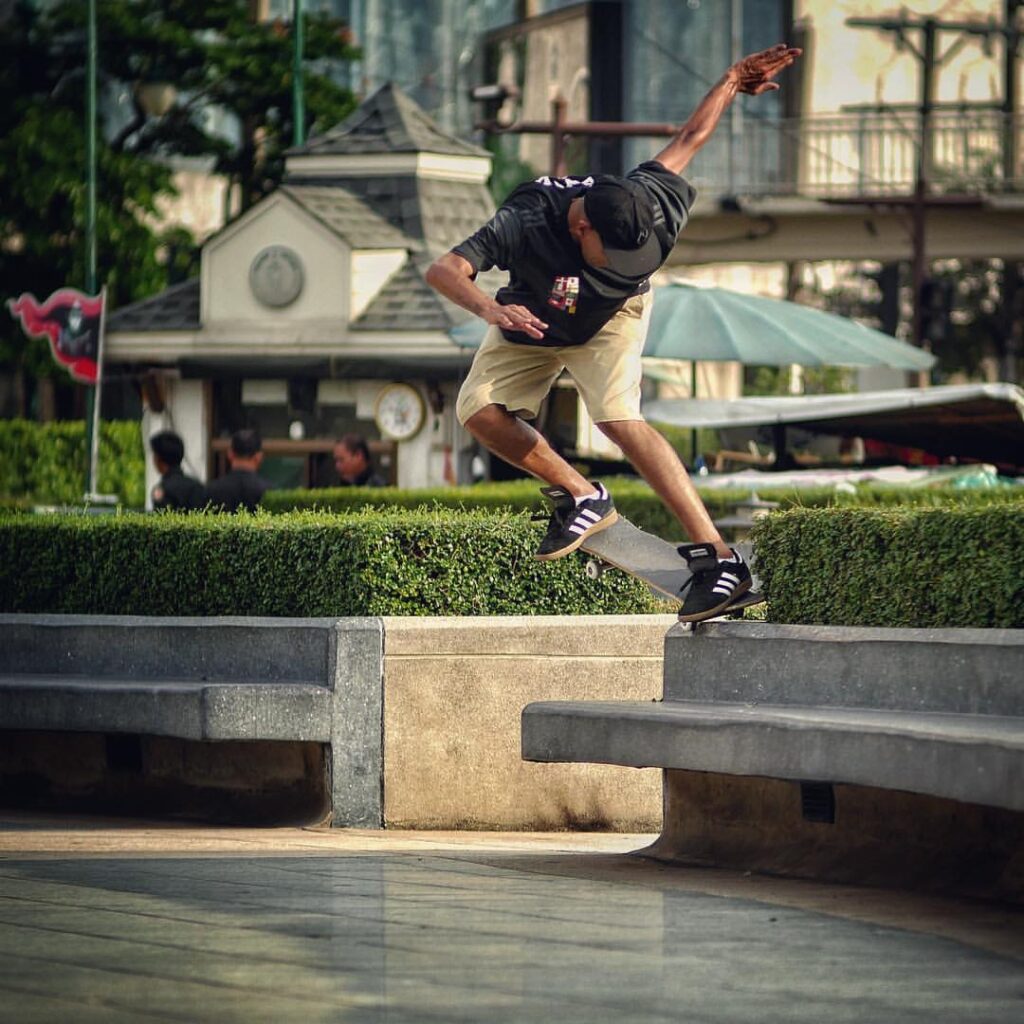
Rodrigo TX, Switch Backside 180 Nosegrind, Bangkok, Thailand: Shot by Anthony
What about Wieger?
Wieger was a kid who I kinda found. I was like he’s an awesome dude. I wanted him to ride for The Firm and he got on The Firm.
Javier Sarmiento too. I loved how he skated, he was my favourite skater and he also ended up riding for The Firm. And that was kind of like my crew. Even though I filmed a lot of Matt Beach’s part, a lot of Ray and a lot of Bob. It was mostly Wieger, Rodrigo and Javier, that’s who I really filmed the lion’s share of all of their parts.
Kurt Hayashi (RIP). Back then you would have this kind of symbiotic relationship. You would have the filmer and photographer. So me and Joe Brook, we were that crew. Joe was a photographer and I was a filmer. Jon Humphries was a photographer and Kurt Hayashi was a filmer.
How I came to the firm with Frank, is how they came to The Firm with Matt Beach. So it was very much that. Kurt filmed Matt’s part, he was based in Orange County with Jon, staying within walking distance from Lance and he ended up filming a lot of Ray, and a lot of Bob. But Wieger, Rodrigo, Javier, that was me. Jon and Kurt edited but I picked Rodrigo, Javi and Wieger’s songs.
Those were sick choices.
Some of it was like, this would be amazing and Lance took a chance and said oh yeah that could work. I wanted Rodrigo to skate to “Deadly Combination”. You know it’s Big L, Biggie, and Tupac but Lance is a devout Christian and there’s a line in Big L’s verse about raping Mary, mother of God and I knew that wasn’t going to go over well.
But then I was like he can skate to the instrumental and Lance was like yeah ok, that works so there was a bit of compromise in there, you know what I mean.
Yeah for sure
You couldn’t have that line in a Firm video. Let’s just say that. There are also different generations. Rodrigo wanted to skate to hip-hop. He was Brazilian and the Brazilian song “Já Sei Namorar” by Tribalistas he skated to was a huge hit and the whole Brazilian crew was all listening to it and I was like this would be a really good song for a video part.
It was a huge song in Brazil but nobody knew it outside of Brazil. I was like this song has a certain feeling, it captures a certain kind of skating and feel of Rodrigo’s skating and we followed that with pure hip hop even though it’s the instrumental, it’s like Big L, Biggie, Tupac, it’s insane. It’s probably one of the hardest tracks ever. All of those dudes are dead.
How do you mean you discovered Wieger?
So the same year that I went to Holland I think in 1998, that year that I met Kaspar.
Wieger, so I was filming a spot check at the skatepark in Holland. Every good skater in Holland came down. They knew the 411 dude was coming down to film, so they all came down. And there was a little kid who was like 15/16 with orange hair and a crooked Menace hat skating and he was cool, he was good and he filmed a couple of tricks and he tried to do a long Tailslide and he slammed and nearly died doing that trick and so that turned out to be Wieger.
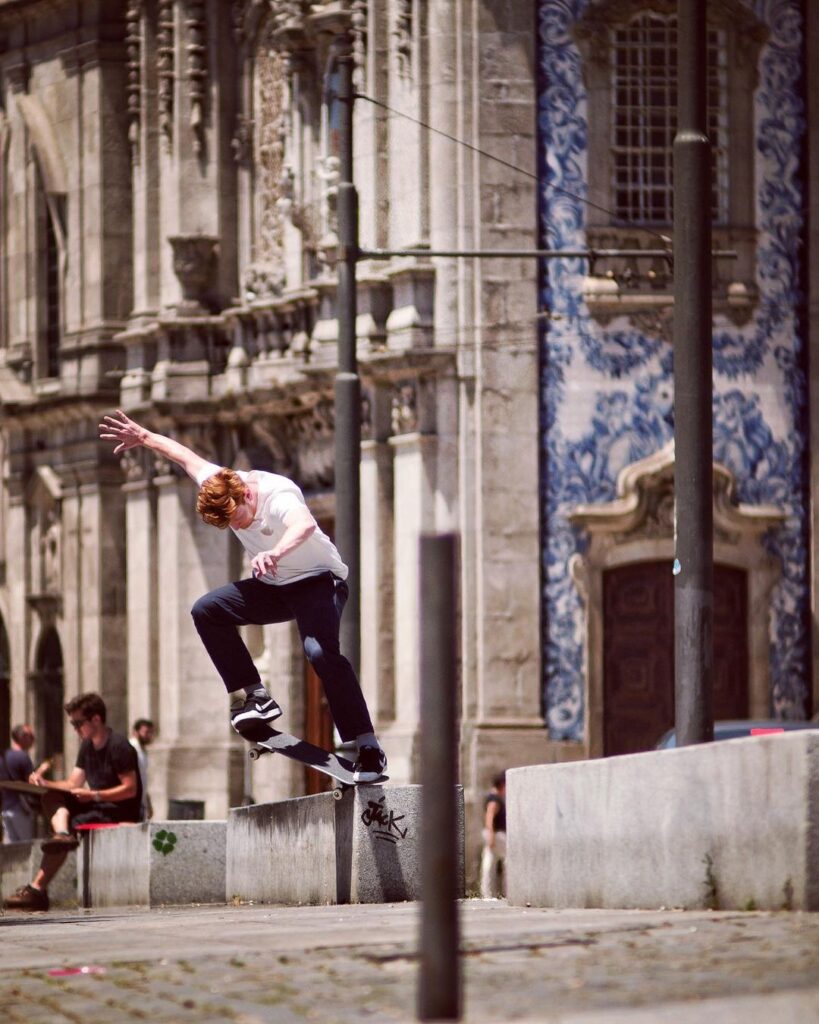
Wieger, Switch Crook: Shot by Anthony
Later on in the trip, or maybe the next year. I went to his town to film another kid, another really good kid and that kid came out and Wieger came with him.
We were staying in Rotterdam and we went to this other town that was 2hrs away. It was me and Joe Brook and we were like we’ve got to take the last rain and he was like you can stay at my house. He was like my parents were out of town. Me and Joe were like fuck it, yeah.
So we stayed at his house and that was Wieger’s place. We started skating with him and he ripped. He was the little homie. I just always had him in the back of my mind. I told Lance Mountain about him, this kid is sick, he does different tricks and he does them really well and it was a fair bit of convincing to get Lance on board, but it finally worked.
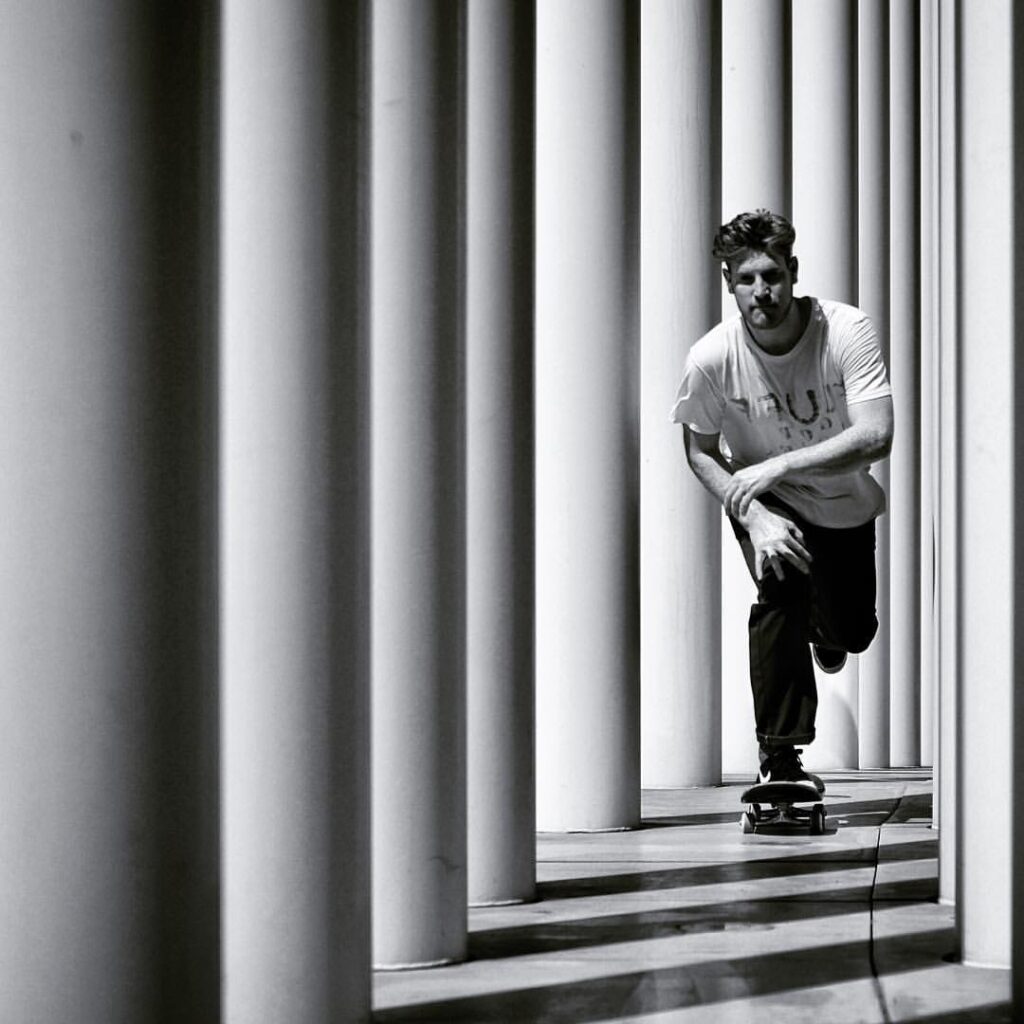
Wieger: Shot by Anthony
What about Javier, how did you get him on The Firm?
Javi. I worked for Powell for a little bit. Went on tour. Ended up at Wembley in London for Generation 97’ Contest. I was with the Powell team, the main team and there’s this kid, skating all Powell, Powell board Powell t-shirt, ripping. One of the best skaters I’ve ever seen. I was like who’s that dude? Does he ride for Powell? Somebody on the team like Mike V or whatever was like nah, he does not ride for Powell.
I was like he’s got a Powell Board, Powell T-Shirt, everything and he’s skating better than the Powell team. They were like he gets stuff from the distributor but I was like fuck dude, he’s good enough to be on the team. I don’t think I even said two words to him but I saw him at that contest.
Then the next summer, I went to Spain and went to a contest and knew the distributor, who sponsored Javi and he also did The Firm. Javi did not speak any English. Well, he did but he pretended not too. We bonded over hip-hop. I was like dude I want to film this guy. I went out to Spain to film with him, I took him out to Brazil. The first time we went out he met TX, and they became really good friends.
It was a little bit fucked up because I had to convince Javi to quit Powell to ride for The Firm. It’s a shame because I respect all of the things that those guys do, it wasn’t so cut and dry as to leave one for the other but it ended up being like that.
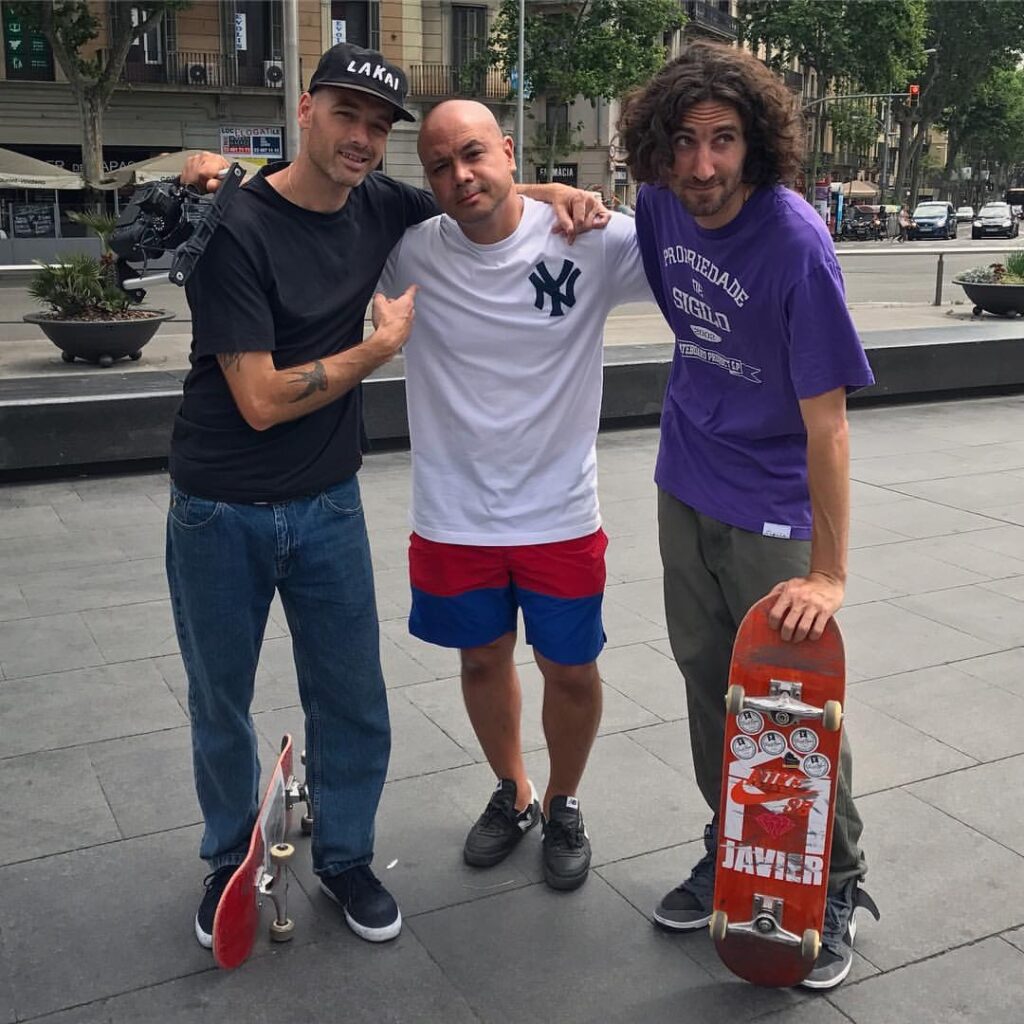
Anthony, Javier Sarmiento and Jesus Fernandez, Universitat, Barcelona: Shot by Pedro Biagio
It’s got to go down like that sometimes.
I tried to do it the right way. I talked to the friend who was the TM there. Who’s still there, he’s the brand manager for Bones. I tried to do it right. It’s not like I discovered him or Wieger. I was just lucky enough in a position to see them skate. TX is the same.
How did Javier’s first go Kickflip Backside Noseblunt go down?
Javi is the best skater and the worst person to film with. He sucks. He does everything really fast before you can set up. He does something if he feels it. If it doesn’t work immediately he gives up and he tries something else. You’re just like nah do that, stick with that, get that.
That Kickflip Backside Nosebluntslide is one of the few tricks that he did that he actually tried. I’d say 90 percent of that part is like he was doing something, I turned on the camera I’d run over and he did it. I didn’t get to film it how I wanted to.
The Kickflip Backside Noseblunt was maybe the only trick in there that he tried and I was like dude you have to do this. To the point where he almost did it and he almost did it.
At that time, it was a really impressive trick and especially to do it that proper, but it was not easy and then we started joking around and being like this one, ‘first try’ and the next one ‘first try’
So even though he’d been trying it, it would be ‘first try’. So eventually he did it perfectly and I was like ‘first try incredible’ but in the video, they muted out my voice, so it looked like he actually landed it first try. So it was not first try, it was not at all. It wasn’t even meant to be, just to play it off as a little bit of a joke. There were quite a lot of tries.
As if
The craziest thing I even talked to TX the other day. TX was like I was there. I was like no you weren’t there because I looked at the footage. It was just me and Javi. Then I looked at the footage and I realised he was there but it took so long that Rodrigo and another homie went and ate and were gone for 2 hours. He did the trick Rodrigo came back and he did another two tricks down the hubba.
I was thinking it was two separate trips, two different days but he had left. He was there, left, and came back and he didn’t even see the trick. This was 20 years ago and your mind plays tricks on you. I was going through the tapes years later and when Javi did it, there was nobody there.
No way. We always thought that was first try
But Javi would do a lot of things first try. He did. A lot of times he would do that. But sometimes if somebody does things first try, it doesn’t always work out, it takes a few tries for people to get the right angle and for your filmer to capture them well. It became a thing where he’d do things so fast and it would suck to film.
That was a slick piece of editing
The editing was all Kurt and Jon. I would have used the clip but I would have left my voice in it because it was more real.
It works but it creates the illusion that it was first try but skateboarding is built on those myths.
Who’s your favourite skater-filmer team right now?
There’s a certain amount of trust that has to go into it. It’s hard man. A good example is let’s say Tom Knox.
Tom Knox is one of the best skateboarders. So if you talk about the best skateboarder to come out of the UK, historically, I’d give it to Penny, Danny and Rowley but today I’d give it to Tom Knox.
In my mind, in my opinion, today Tom Knox is the best. The insane video parts he’s put out and what he’s done. But there’s no Tom Knox the skater if you don’t have the amazing filmer. It’s like they are together. I’m a huge, huge fan of Jacob Harris as a filmer and editor. You can’t have one without the other.
But on the flip side, you’ve filmed with hundreds of skaters. How do you deal with filming with so many people and meeting and approaching new skaters to film?
It’s almost like a bedside manner, like a doctor. You go to see a doctor and a good doctor, you meet them immediately and they are like how are you doing? You have to put people at ease. You have to realise it’s an anxious situation, they could tell you that you have cancer or they could tell you you are fine and tell you to brush your teeth and floss more.
Somebody is skating a 20 stair rail and you have to give them the ability or the confidence that you can do the job. It’s fucked. I reference Griffin as someone I’ve filmed.
The first time we filmed was 3 days ago and yesterday, we filmed something mellow. The next day he tried something for a while, but he couldn’t quite get it and yesterday he got two really good clips. But he has to know how serious I am about filming his trick for him to give as much energy to it.
Yeah, they have to know it’s going to be an equal partnership.
It’s also a generational thing. It’s really kind of fucked. I’ve filmed with a lot of young kids, who don’t really know where I came from. I’m 50 years old. I’m in the street. I’m older than the cops kicking us out. I’m older than the lady who’s screaming you guys are going to hurt yourself. You fucking kids. They look at me and they’re like, this guy is older. There’s no point of reference for kids I want to film with. Sometimes there are kids whose dads are like this guy is a legend, he’s filmed this and that.
The craziest thing is where I film with a bunch of kids and a video I worked on back in the day comes up in conversation, and they’re all like that was the first video that I ever saw.
Were you there when Bob did the Switch Loop in the hole with it?
The thing about Bob was that he was always trying crazy shit that had never been done. Or where’d you’d be like can it even happen. He was so hard on his body. He would try a trick and slam and lay on the ground for like 10 minutes .You’d be like is he fucked, do we need to call the ambulance?
Then he would get up and go back and try it again. Even the way he skated, he would push himself to the limit. Literally. Duct taping his ankles and skating on them. Still skating and trying to get this trick and thinking shit I have to get this trick now because I’m going to tighten up and my back is going to spasm because I’m not even going to be able to try it.
Any Bob Burnquist stories come to mind before I let you go?
There’s a clip where he does a Gap to Noseslide on a handrail. The handrail has a little centre divider and he has to gap the Noseslide past the divider. The story with that was we were in Japan. He just had knee surgery. He could not skate, he could only push. Just push. We’re skating. He’s not supposed to be skating. We get to the spot. We look at the rail.
Then he starts doing Noseslides on a ledge. Noseslide, Noseslide, Noseslide, I was joking with him and I was like you’ve just got to do it first try. Then he said I have to do it first try, I can’t slam, I have to do it. I was just like this guy’s trying to skate this handrail, first thing after surgery and he’s not even clear to skate. And he fucking did it.
He did it in like 2 or 3 tries. It’s in his Can’t Stop part. It’s just a clip but the story behind that is so insane. It just shows you who he is as a skateboarder. He’s one of the very best.

